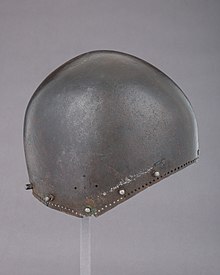|
Cervelliere  A cervelliere (cervelière, cervelliera;[1] Latin: cervellerium,[2] cerebrarium,[3] cerebrerium, cerebotarium[4]) is a hemispherical, close-fitting[5] skull cap of steel or iron.[3] It was worn as a helmet during the medieval period and a version known as a secret was worn under felt hats during the Wars of the Three Kingdoms in the early modern period. HistoryThe cervelliere was first introduced during the late 12th century. It was worn either alone or more often over or under a mail coif.[5] Additionally, a great helm could be worn over a cervelliere,[5] and by the late 13th century this was the usual practice.[citation needed] Over time, the cervelliere experienced several evolutions. Many helmets became increasingly pointed and the back of the skull cap elongated to cover the neck, thus developing into the bascinet.[6] Cerveillieres were worn throughout the medieval period and even during the Renaissance.[7] They were cheap and easy to produce and thus much used by commoners and non-professional soldiers who could not afford more advanced protection. Anecdotally, medieval literature credits the invention of the cervellière to astrologer Michael Scot c. 1233,[1] though this is not seriously entertained by most historians.[1] The Chronicon Nonantulanum[note 1] records that the astrologer devised the iron-plate cap shortly before his own predicted death, which he still inevitably met when a stone weighing two ounces fell on his protected head.[2][3] Notes
References
|
